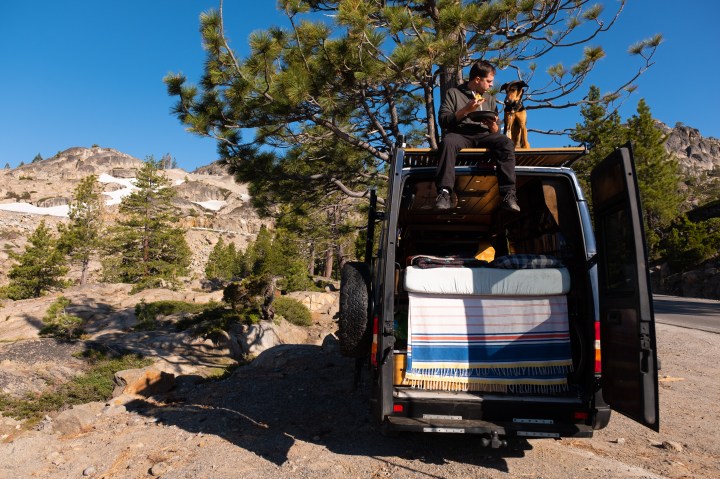
Dream big, live small: Why “van lifers” are trading four walls for four wheels
Dream big, live small: Why “van lifers” are trading four walls for four wheels

The bank of Northern California’s South Yuba River was quiet on a spring evening, until a young man pulled his rumbling navy blue Dodge van up to the water.
The driver, who uses the professional name Travis Wild, was looking for a new campsite to call home. He’s 31, and has been living in his van for about three years.
Wild is part of a community of 20-and-30-somethings who are ditching the idea of home ownership and choosing to live in vehicles. They call it the “van life,” and it centers around the idea that experiences are more valuable than things.
Inside Wild’s van, the walls are pine and the floor is bamboo. The bed is surrounded by bookshelves, and a surfboard hangs from the ceiling. There are lots of space-saving tricks, including built-in drawers along the walls and a table that slides out from underneath the sleeping platform.

Wild bought the 2006 Dodge Sprinter van for $14,000, then spent $10,000 on the build-out and $2,000 on the mechanics. He’s a wedding photographer, and between shoots and some extra cash from blogging makes about $36,000 a year. Before this, he lived on a rented boat near San Diego and worked in the travel industry.
He has health insurance, and so does his dog, Ayla. He doesn’t have a retirement plan, but said he’s paying off credit card debt and making plans to invest. Finances can be stressful, but Wild says the freedom is worth it.
“I’m writing, I’m getting to see a lot more, I get to meet a lot of people,” he said. “And if something happens next week in Colorado I want to go see, I go see that.”
It’s hard to quantify how many people are choosing this lifestyle as opposed to living in cars out of necessity. But the four or five big “van life” gatherings a year draw hundreds of people.
And there are those who spend tens of thousands of dollars on their vans. One popular brand is the Mercedes-Benz Sprinter. The cargo version starts at about $34,000 and can be tricked out with more add-ons.
Some people, like Josh Thompson, just retrofit their own. He was sawing wood for a sleeping platform in his Dodge Ram 2500 on a recent afternoon, taping off sections for cabinets, counters and bike storage.
Thompson, age 34, served in the coast guard and was an outdoor instructor for a while, but now just wants to hit the road.
“Life’s pretty short,” he said. “Minimal living allows you the freedom to make choices about what you do with your time, what you do with your money.”
Van life fits the millennial profile, according to Gabrielle Lewine, a graduate student in psychology at the University of Southern California who’s researched this demographic.
“In the same way that millennials are, to use the very trendy word, “disrupting” other marketplaces … nontraditional living situations are just another piece of that trend,” she said.
And the downsides? Finding a place where it’s legal to park overnight for free. Wild said vehicle maintenance and Internet connectivity can also be a struggle.
“So there’s always these little kinks that, at first, you’re like: ‘this is part of the adventure,’ and then you’re like: ‘it’s rainy, and I have to stay inside here a little more than I would have liked to,’” he said.
None of that is a deterrent for Wild — yet. But he said he might consider leaving the van life if he found a partner who wanted to settle down.
There’s a lot happening in the world. Through it all, Marketplace is here for you.
You rely on Marketplace to break down the world’s events and tell you how it affects you in a fact-based, approachable way. We rely on your financial support to keep making that possible.
Your donation today powers the independent journalism that you rely on. For just $5/month, you can help sustain Marketplace so we can keep reporting on the things that matter to you.












